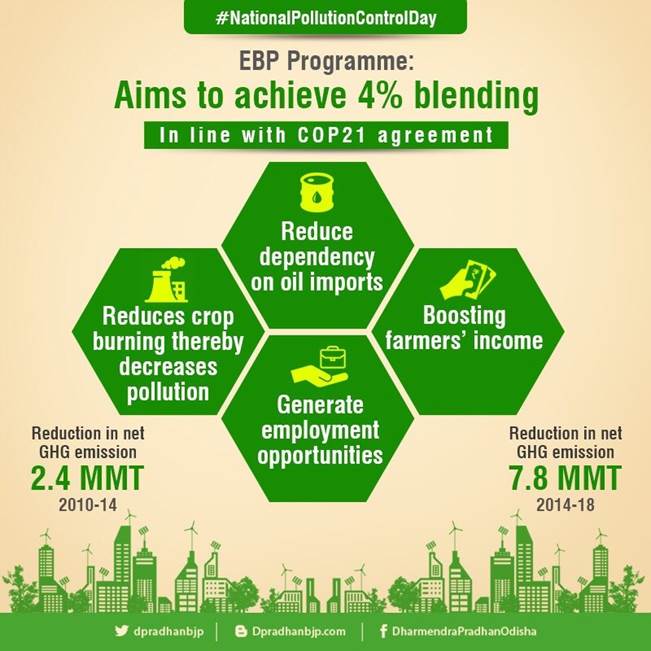Description

Disclaimer: Copyright infringement not intended.
Context
- On the occasion of World Biofuel Day, Prime Minister Narendra Modi dedicated the 2nd generation (2G) ethanol plant set up at the Indian Oil Corporation’s Panipat refinery in Haryana.
- This plant will not only help reduce air pollution from the Delhi–NCR region but also help generate additional income and green fuel.
Biofuels
- Biofuels are liquid or gaseous fuels primarily produced from biomass —that is, plant or algae material or animal waste.
- Biofuels can be used to replace or can be used in addition to diesel, petrol or other fossil fuels for transport, stationary, portable and other applications.
- Ethanol and biodiesel are the two main transport biofuels. These fuels can be produced from a variety of biomass.
Categories of biofuels
- First generation biofuels- First-generation biofuels are made from sugar, starch, vegetable oil, or animal fats using conventional technology. Common first-generation biofuels include Bioalcohols, Biodiesel, Vegetable oil, Bioethers, Biogas.
- Second generation biofuels -These are produced from non-food crops, such as cellulosic biofuels and waste biomass (stalks of wheat and corn, and wood). Examples include advanced biofuels like biohydrogen, biomethanol.
- Third generation biofuels- These are produced from micro-organisms like algae.
- Fourth generation biofuels- These are produced from genetically modified (GM) algae to enhance biofuel production.
Note: The prices of both sugarcane and bio-ethanol are set by the central government.
India’s Biofuel Economy
- India is one of the fastest growing economies and the third largest consumer of primary energy in the world after the US and China.
- India’s fuel energy security will remain vulnerable until alternative fuels are developed based on renewable feedstocks.
- The government of India targets reducing the country’s carbon footprint by 30-35% by the year 2030.
- These targets will be achieved through a five-pronged strategywhich includes:
- Increasing domestic production
- adopting biofuels and renewable
- implementing energy efficiency norms
- improving refinery processes and
- achieving demand substitution.
- The government of India has proposed a target of 20% blending of ethanol in petrol and 5% blending of biodiesel in diesel by 2030and introduced multiple initiatives to increase indigenous production of biofuels.


What are 1G and 2G biofuels?
- 1G Bioethanol plants utilise sugarcane juice and molasses, byproducts in the production of sugar, as raw material.
- 2G plants utilise surplus biomass and agricultural waste to produce Bioethanol.
- Third generation biofuels- These are produced from micro-organisms like algae.
- Fourth generation biofuels- These are produced from genetically modified (GM) algae to enhance biofuel production.
- The prices of both sugarcane and bio-ethanol are set by the central government.

Benefits of India’s ethanol blending mandates include:
- Reduce Import Dependency: Will saves foreign exchange (forex).
- Cleaner Environment: Reducing crop burning and converting agricultural residues/wastes to biofuels will further reduce greenhouse gas (GHG) emissions.
- Health Benefits:Prolonged reuse of cooking oil for preparing food, particularly in deep-frying, is a potential health hazard and can lead to many diseases. Used cooking oil (UCO) is a potential feedstock for biodiesel and its use for making biodiesel prevents reuse of UCO within the food industry.
- Solid Waste Management: There are technologies available, which can convert solid waste and plastics to drop-in fuels.
- Infrastructural Investment in Rural Areas:Establishing additional 2G biorefineries across the country will spur infrastructural investment in rural areas.
- Employment Generation:2G biorefinery can contribute 1200 jobs across plant operations, village level entrepreneurs and supply chain management.
- Additional Income to Farmers:By adopting 2G technologies, agricultural residues/wastes that otherwise are burnt can be converted to ethanol. Farmers can realise an additional revenue source if markets are developed for these residues/wastes.
Major programs supporting the development of biofuels production and use in India include:
- Viable gap funding (VGF)for commercial scale 2G ethanol plants under Pradhan Mantri JI-VAN Yojana
- Financial assistance for demonstration scale 2G integrated bioethanol under Pradhan Mantri JI-VAN Yojana.
- Grants for research and development from DBT to 5 Centres for Excellence in the Bioenergy area.
- The National Policy on Biofuels 2018specifically promotes advanced biofuels to achieve a target of 20% blending of biofuels with fossil-based fuels by 2030.
Measures that can improve Bio-fuel economy:
- Currently in India, Biofuel development is centred around the cultivation of Jatropha plant seeds. There is need to develop new feedstock for biofuels.
- To facilitate the blending of biofuels with conventional fuels, there is need to set up advanced biorefineries.
- Research and development should be promoted to support generation of bio-fuel from waste. As it will ensure realizing the goal of waste management and waste to energy.
https://www.hindustantimes.com/cities/chandigarh-news/world-biofuel-day-pm-modi-dedicates-2g-ethanol-plant-in-panipat-101660168453508.html

















